A prehistoric pelvis, nicknamed "Elvis," and other fossilized bones are what's left of the world's first known elderly human with clear signs of aging and impairment, according to a paper in the latest Proceedings of the National Academy of Sciences.
The remains, which date back to 500,000 years ago, also represent the earliest post-cranial evidence for an aged individual in the human fossil record.
The elderly fellow, who lived in Spain, was a member of the species Homo heidelbergensis, a type of ancient human believed by some to be exclusive to Europe and ancestral only to Neanderthals.
Modern humans are thought to descend from the Middle Pleistocene African species Homo rhodesiensis. Since that species and Homo heidelbergensis shared a common "grandfather species" around one million years ago, "this (elderly male) individual would belong to our 'uncle' species, meaning he is not ancestral but closely related," lead author Alejandro Bonmati told Discovery News.
Bonmati, a researcher at Complutense University of Madrid and the Carlos III Institute of Health, and his colleagues unearthed the lower back and pelvis for the aged individual at a site called Sima de los Huesos in Spain.
The male's remains were found among some 6,000 other fossils at the site, which was once likely home to numerous humans from the now-extinct species.
Analysis of the fossils indicates the male Homo heidelbergensis was over age 45 and suffered from a spinal deformity that would have caused him a lot of pain and forced him to stoop over. It's not clear how much older than 45 he was. The researcher, however, are certain that he was elderly based on his remains.
"He possibly used a cane, just as a modern elderly person does," Bonmati said. "This individual may not have been an active hunter and was impaired to carry heavy loads, thus an important source of his food would depend on other members of the group, which would mean sharing."
As a senior, the individual would have had expertise in finding food and more, the researchers suspected, so he must have been a valuable contributor to his group. As a result, the male may also provide some of the world's first evidence for compassion and cooperation among early humans.
"We wouldn't say that he was a burden to his group, but rather that this was a greatly socialized group with solidarity bonds between individuals," Bonmati said.
Homo heidelbergensis had a large brain and certain anatomy, such as a highly developed inner ear, he explained. These features suggest this species had some form of spoken language that would have helped to bond individuals together.
The findings come on the heels of yet another new study, published in the journal Time and Mind, which describes the discovered remains of a Neanderthal child with a congenital brain abnormality who was not abandoned, but instead lived until the about age five or six.
The paper mentions yet another Neanderthal individual who would have required care: someone with a withered arm, deformed feet and blindness in one eye who lived to about age 20.
Lead author Penny Spikins, a University of York archaeologist, said all provide evidence for compassion among early humans.
"Compassion is perhaps the most fundamental human emotion. It binds us together and can inspire us, but it is also fragile and elusive," she said.
"This apparent fragility makes addressing the evidence for the development of compassion in our most ancient ancestors a unique challenge," Spikins added, "yet the archaeological record has an important story to tell about the prehistory of compassion."
